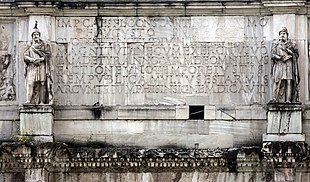
The Dacians (/ˈdeɪʃənz/; Latin: Daci [ˈdaːkiː]; Greek: Δάκοι,[1] Δάοι,[1] Δάκαι[2]) were the ancient Indo-European inhabitants of the cultural region of Dacia, located in the area near the Carpathian Mountains and west of the Black Sea. They are often considered a subgroup of the Thracians.[3][4][5] This area includes mainly the present-day countries of Romania and Moldova, as well as parts of Ukraine,[6] Eastern Serbia, Northern Bulgaria, Slovakia,[7] Hungary and Southern Poland.[6] The Dacians and the related Getae[8] spoke the Dacian language, which has a debated relationship with the neighbouring Thracian language and may be a subgroup of it.[9][10] Dacians were somewhat culturally influenced by the neighbouring Scythians and by the Celtic invaders of the 4th century BC.[11]
| This article is part of a series on |
 |
| Dacia |
| Geography |
|---|
| Culture |
| History |
| Roman Dacia |
| Legacy |

- ^ a b Strabo & 20 AD, VII 3,12.
- ^ Dionysius Periegetes, Graece et Latine, Volume 1, Libraria Weidannia, 1828, p. 145.
- ^ Waldman & Mason 2006, p. 205.
- ^ Bunson 1995.
- ^ Waldman & Mason 2006, p. 205 "The Dacians were a people of present-day Romania, a subgroup of THRACIANS, who had significant contacts with the ROMANS from the mid-second century B.C.E. to the late third century C.E."
- ^ a b Nandris 1976, p. 731.
- ^ Husovská 1998, p. 187.
- ^ The Cambridge Ancient History (Volume 10) (2nd ed.). Cambridge University Press. 1996. J. J. Wilkes mentions "the Getae of the Dobrudja, who were akin to the Dacians"; (p. 562)
- ^ Fisher 2003, p. 570.
- ^ Rosetti 1982, p. 5.
- ^ Mountain 1998.
- ^ Westropp 2003, p. 104.